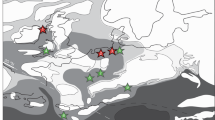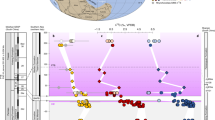Abstract
Organic-rich sedimentary units called sapropels have formed repeatedly in the eastern Mediterranean Sea, in response to variations of solar radiation. Sapropel formation is due to a change either in the flux of organic matter to the sea floor from productivity changes or in preservation by bottom-water oxygen levels. However, the relative importance of surface-ocean productivity versus deep-water preservation for the formation of these organic-rich shale beds is still being debated, and conflicting interpretations are often invoked1,2,3,4,5,6,7. Here we analyse at high resolution the differences in the composition of the most recent sapropel, S1, in a suite of cores covering the entire eastern Mediterranean basin. We demonstrate that during the 4,000 years of sapropel formation, surface-water salinity was reduced and the deep eastern Mediterranean Sea, below 1,800 m depth, was devoid of oxygen. This resulted in the preferential basin-wide preservation of sapropel S1 with different characteristics above and below 1,800 m depth as a result of different redox conditions. We conclude that climate-induced stratification of the ocean may therefore contribute to enhanced preservation of organic matter in sapropels and potentially also in black shales.
This is a preview of subscription content, access via your institution
Access options
Subscribe to this journal
Receive 12 print issues and online access
$259.00 per year
only $21.58 per issue
Buy this article
- Purchase on Springer Link
- Instant access to full article PDF
Prices may be subject to local taxes which are calculated during checkout



Similar content being viewed by others
References
Erbacher, J., Huber, B. T., Norris, R. D. & Markey, M. Increased thermohaline stratification as a possible cause for a Cretaceous anoxic event. Nature 409, 325–327 (2001).
Arthur, M. A., Brumsack, H.-J., Jenkyns, H. C. & Schlanger, S. O. in Cretaceous Resources, Events, Rhythms (eds Ginsburg, R. N. & Beaudoin, B.) 75–119 (Kluwer–Academic, Dordrecht, 1990).
Rohling, E. J. Review and new aspects concerning the formation of eastern Mediterranean sapropels. Mar. Geol. 122, 1–28 (1994).
Emeis, K. C., Sakamoto, T., Wehausen, R. & Brumsack, H.-J. The sapropel record of the eastern Mediterranean—results of Ocean Drilling Program Leg 160. Palaeogeogr. Palaeoclimatol. Palaeoecol. 158, 371–395 (2000).
Rossignol-Strick, M., Nesteroff, W., Olive, P. & Vergnaud-Grazzini, C. After the deluge Mediterranean stagnation and sapropel formation. Nature 295, 105–110 (1982).
Thomson, J., Mercone, D., de Lange, G. J. & van Santvoort, P. J. M. Review of recent advances in the interpretation of Eastern Mediterranean sapropel S1 from geochemical evidence. Mar. Geol. 153, 77–89 (1999).
Van Santvoort, P. J. M. et al. Active post-depositional oxidation of the most recent sapropel (S1) in the eastern Mediterranean. Geochim. Cosmochim. Acta 60, 4007–4024 (1996).
Reitz, A., Thomson, J., De Lange, G. J. & Hensen, C. Source and development of large manganese enrichments above eastern Mediterranean sapropel S1. Paleoceanography 21, PA3007 (2006).
Mercone, D. et al. Duration of S1, the most recent sapropel in the eastern Mediterranean Sea, as indicated by AMS radiocarbon and geochemical evidence. Paleoceanography 15, 336–347 (2000).
Kallel, N. et al. Enhanced rainfall in the Mediterranean region during the last sapropel event. Oceanol. Acta 20, 697–712 (1997).
Rohling, E. J. Environmental control on Mediterranean salinity and δ18O. Paleoceanography 14, 706–715 (1999).
Emeis, K. C. et al. Eastern Mediterranean surface water temperatures and δ18O composition during deposition of sapropels in the late Quaternary. Paleoceanography 18, 1005 (2003).
Murat, A. & Got, H. Organic carbon variations of the eastern Mediterranean Holocene sapropel: A key for understanding formation processes. Palaeogeogr. Palaeoclimatol. Palaeoecol. 158, 241–257 (2000).
Béthoux, J. P. Mediterranean sapropel formation, dynamic and climatic viewpoints. Oceanol. Acta 16, 127–133 (1993).
Roether, W. & Well, R. Oxygen consumption in the Eastern Mediterranean. Deep-Sea Res. 1 48, 1535–1551 (2001).
Casford, J. S. L. et al. A dynamic concept for eastern Mediterranean circulation and oxygenation during sapropel formation. Palaeogeogr. Palaeoclimatol. Palaeoecol. 190, 103–119 (2003).
Passier, H. F., Middelburg, J. J., Van Os, B. J. H. & de Lange, G. J. Diagenetic pyritisation under eastern Mediterranean sapropels caused by downward sulphide diffusion. Geochim. Cosmochim. Acta 60, 751–763 (1996).
Moodley, L., Middelburg, J., De Lange, G. J. & Herman, P. M. J. Oxygenation and organic-matter preservation in marine sediments. Direct experimental evidence from ancient organic-carbon rich deposits. Geology 33, 889–892 (2005).
Cheddadi, R. & Rossignol Strick, M. Improved preservation of organic matter and pollen in Eastern Mediterranean sapropels. Paleoceanography 10, 301–309 (1995).
Zonneveld, K. A. F., Versteegh, G. J. M. & De Lange, G. J. Palaeo-productivity and post-depositional aerobic organic matter decay reflected by Eastern Mediterranean dinoflagellate cyst assemblages. Mar.Geol 172, 181–195 (2001).
Hartnett, H. E., Keil, R. G., Hedges, J. I. & Devol, A. H. Influence of oxygen exposure on organic carbon preservation in continental margin sediments. Nature 391, 572–574 (1998).
Hedges, J. et al. Sedimentary organic matter preservation: a test for selective degradation under oxic conditions. Am. J. Sci. 299, 529–555 (1999).
Van Santvoort, P. J. M. et al. Oxidation and origin of organic matter in surficial eastern Mediterranean hemipelagic sediments. Aquat. Geochem. 8, 153–175 (2002).
Myers, P. G., Haines, K. & Rohling, E. J. Modelling the paleo-circulation of the Mediterranean: The Last Glacial Maximum and the Holocene with emphasis on the formation of sapropel S1. Paleoceanography 13, 586–606 (1998).
Stratford, K., Williams, R. G. & Myers, P. G. Impact of the circulation on sapropel formation in the eastern Mediterranean. Glob. Biogeochem. Cycles 14, 683–695 (2000).
Schenau, S. J., Prins, M. A., De Lange, G. J. & Monnin, C. Barium accumulation in the Arabian Sea: Controls on barite preservation in marine sediments. Geochim. Cosmochim. Acta 65, 1545–1556 (2001).
Reitz, A. & De Lange, G. J. Abundant Sr-rich aragonite in eastern Mediterranean sapropel S1: Diagenetic versus detrital/biogenic origin. Palaeogeogr. Palaeoclimatol. Palaeoecol 235, 135–148 (2006.).
Rutten, A. & De Lange, G. J. A novel selective extraction of barite and its application to eastern Mediterranean sediments. Earth Planet. Sci. Lett. 198, 11–24 (2002).
Thouveny, N. et al. Rock magnetic detection of distal ice-rafted debris: Clue for the identification of Heinrich layers on the Portuguese margin. Earth Planet. Sci. Lett. 180, 61–75 (2000).
Acknowledgements
On-board assistance by ship and scientific teams during cruises with Marion Dufresne (1991, 1995), Tyro (1987, 1991, 1992, 1993), Logachev (1999), Urania (1994, 1997) and Pelagia (2000, 2001, 2004) is acknowledged. We thank M. Paterne, S. Troelstra and the British Ocean Sediment Core Research Facility (BOSCORF) for samples from archive cores; K. van der Borg and A.F.M. de Jong, and the NERC Radiocarbon Laboratory for 14C analyses; and D. Mercone, D. Green, G. Nobbe, H. de Waard, G. Peters, D. van der Meent, R. Knoop, S. Gusic, P. Knutz, C. de Ioanna and E. Schefuss for analytical assistance. This work was supported by European (SAP) and national scientific organizations (Pass2, Saps)
Author information
Authors and Affiliations
Contributions
G.J.D.L. and J.T. were responsible for geochemical results and interpretation; A.R. and C.P.S. contributed to geochemical results; M.S.P., E.E. and C.C. were responsible for micropalaeontological results. All authors agree to all of the content in the manuscript including the data as presented
Corresponding author
Supplementary information
Supplementary Information
Supplementary figures S1-S4 (PDF 552 kb)
Rights and permissions
About this article
Cite this article
De Lange, G., Thomson, J., Reitz, A. et al. Synchronous basin-wide formation and redox-controlled preservation of a Mediterranean sapropel. Nature Geosci 1, 606–610 (2008). https://doi.org/10.1038/ngeo283
Received:
Accepted:
Published:
Issue Date:
DOI: https://doi.org/10.1038/ngeo283
This article is cited by
-
Hydroclimate variability in the central Mediterranean during MIS 17 interglacial (Middle Pleistocene) highlights timing offset with monsoon activity
Scientific Reports (2023)
-
Eastern Mediterranean water outflow during the Younger Dryas was twice that of the present day
Communications Earth & Environment (2023)
-
Rapid light carbon releases and increased aridity linked to Karoo–Ferrar magmatism during the early Toarcian oceanic anoxic event
Scientific Reports (2022)
-
Sill-controlled salinity contrasts followed post-Messinian flooding of the Mediterranean
Nature Geoscience (2022)
-
Drivers of river reactivation in North Africa during the last glacial cycle
Nature Geoscience (2021)



